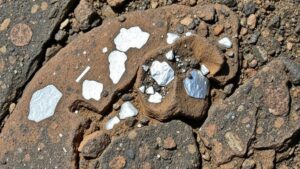How to Spot Areas of Natural Erosion That Reveal Gold in Drylands
How to Spot Areas of Natural Erosion That Reveal Gold in Drylands
Identifying areas of natural erosion that may indicate the presence of gold in dryland regions requires a systematic understanding of geological processes, erosion patterns, and the behavior of sedimentary deposits. Understanding these concepts aids prospectors in pinpointing high-potential locations for gold mining.
Understanding Erosion and Its Role in Gold Discovery
Erosion is the process of wearing away materials from the Earths surface, which can expose gold deposits buried beneath layers of soil and sediment. In dryland environments, factors such as wind and water erosion play a crucial role in this process. When hills and mountains erode, they can release gold particles that have been weathered from their original veins.
- Wind Erosion: Frequently occurs in arid regions, where strong winds can strip away topsoil and expose underlying materials.
- Water Erosion: Rivers and streams can wash away sediments, uncovering gold that may have been deposited via ancient riverbeds.
Identifying Erosional Features in Drylands
Prospectors must learn to identify specific erosional features that suggest the presence of gold. Key indicators include:
- Gullies and Ravines: Steep-sided channels formed by the erosion of water, often revealing rocky deposits rich in gold.
- Talus Slopes: Accumulations of broken rock at the base of cliffs, where gold particles may be present due to weathering and erosion.
- Alluvial Deposits: Sediments transported by water that can contain fine gold particles, typically found in riverbeds or floodplains.
Assessing Geological Context
The geological setting of an area is critical for gold prospecting. Certain rock types are more likely to contain gold. For example, quartz veins within sedimentary rock formations frequently host gold deposits. Understanding the local geology can help prospectors focus their search. Key considerations include:
- Rock Types: Look for quartz, shale, and other metamorphic rocks often associated with gold deposits.
- Fault Lines: These fractures in the Earth’s crust can create pathways for mineralization, making them prime areas to search.
- Historical Mining: Areas with historical records of gold deposits often indicate potential remaining resources.
Employing Analytical Techniques
Modern technology has enhanced the ability to locate potential gold deposits in erosional areas. Several methods include:
- Geophysical Surveys: Techniques like resistivity measurements can reveal underlying features pertinent to gold deposits.
- Geochemical Analysis: Soil sampling and analyzing for trace elements associated with gold, such as arsenic, can indicate proximity to gold.
- Remote Sensing: Satellite imagery and aerial surveys can help identify large-scale erosional features and potential mining sites.
Real-World Applications and Case Studies
Numerous successful gold discoveries result from understanding natural erosional processes. For example, the Golden Triangle region in British Columbia has seen substantial discoveries influenced by glacial and river erosion, exposing rich mineral veins. The Yukon area, often characterized by its rugged terrain and significant erosional features, has also been a hotspot for modern prospectors leveraging advancements in geophysical surveys.
Environmental Considerations
While prospecting for gold is a thrilling venture, it is important to consider environmental impacts. Areas subject to heavy erosion may be ecologically sensitive, and responsible prospecting practices are crucial for minimizing harm. Some considerations include:
- Compliance with Local Regulations: Ensure all activities align with environmental regulations and land use policies.
- Restoration of Sites: Useing practices to restore disturbed areas post-extraction can mitigate long-term impacts.
Conclusion
Spotting areas of natural erosion that may reveal gold in dryland areas involves a keen understanding of geological features, erosion processes, and effective analytical techniques. By combining traditional prospecting with modern technology, individuals can enhance their chances of discovering valuable gold deposits while responsibly navigating the environmental implications of their activities.
Actionable Takeaways
- Study local geological maps to understand the type of rock formations present in the area.
- Use erosion features such as gullies and riverbeds to guide exploration efforts.
- Employ a blend of traditional and new technologies to optimize your prospecting strategy.
- Always prioritize environmental stewardship in your prospecting activities.


